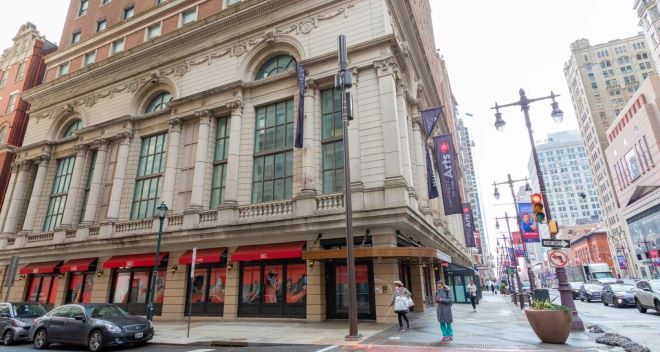The ranks of people left angry and confused over the abrupt closure of UArts have steadily spread outward from the inner rings of displaced students, teachers and staff. They now include lawmakers, lawyers and members of the broader arts community, all of whom continue to ask questions about the decision to close the 150-year-old institution, which the school’s board members claim was in “urgent” financial distress.
As the shock of the school’s closure has set in, another aspect of the UArts conundrum has become the object of speculation: What will become of the 600,000 square feet of the school’s Center City real estate?
Within days of the surprise announcement, developers were already offering their two cents. Luxury developer Carl Dranoff, for one, told the Business Journal that the “possibilities were endless” for the prime real estate occupied for now by UArts, and floated the prospect of adaptive-reuse projects such as apartments, hotels, and other cultural institutions.

But there’s another possibility for the UArts real estate, along with the gobs of office and commercial space sitting empty in the city, which is something that could be even more beneficial to Philadelphia: Transform at least some of those spaces into child-care centers.
Policymakers in New York City and a number of states have recently created incentives to encourage the conversion of existing real estate into child care. At a time when Philly has been struggling (much more than most cities) to draw workers back to Center City, increasing the supply of accessible and affordable child care could be one way to provide a kickstart the city desperately needs.
A broken system
In September 2021, U.S. Secretary of the Treasury Janet Yellen referred to the child-care industry as a textbook example of a broken market. “It does not work for the caregivers. It does not work for the parents. It does not work for the kids. And because it does not work for them, it does not work for the country,” Yellen said.
Those comments accompanied a report that the Treasury Department compiled during the first half of the pandemic, which quantified the mounting troubles for both parents and providers. On the one hand, the average American family was spending 13 percent of their income on quality child care, which was more than the average household spends on food. (For low-income families, the number was substantially higher.) On the other hand, high prices did not signify a healthy sector, as the supply of licensed operators was declining.
To ward off a total collapse of the child-care industry, which some predicted at the beginning of the pandemic, the government invested historic levels of funding. Nearly $2 billion in federal stimulus flowed into Pennsylvania for child care, allowing most daycares and pre-K programs to stay afloat even while more parents stayed home with their kids.
But the stimulus also added new obstacles.
The cost of operating a program soared since the start of the pandemic, largely due to inflation. A 2022 Institute of State and Regional Affairs survey of more than 4,300 providers in Pennsylvania found that the median weekly operating cost of a child-care provider had jumped nearly 17 percent since the end of 2019. More specifically, the survey found that salaries and wages were not the driving factors, having increased modestly over that span. Instead, it was the surging prices of secondary costs such as snacks, equipment and most impactfully, real estate — the second-largest expense for most providers outside of personnel.
As the survey noted: “One implication of these changes is that the cost of entering the child-care industry has risen substantially.”
If the UArts real estate is going to turn into luxury apartments, why not allow for the possibility of co-locating some child-care centers there too?
In the two years since that report came out, the economics of running a child-care business have only grown trickier. The remaining federal block grants and stabilization funds will expire by the end of this year, creating a potential fiscal cliff for local operators.
Meanwhile, a staffing crisis has seeded doubt about the future of the industry. Nationally, more than 40,000 child-care workers left the field during the pandemic, and there is little doubt why: Even as wages for jobs in fast food, retail and hospitality increased substantially over the last several years, daycare and pre-K pay rates remained stagnant. Today, the average child-care worker in the Philadelphia region earns roughly $30,000 per year.
All of which means that providers are scrambling to find ways to offer more money to entice workers back at a time when their finances are as fragile as ever.
In response, lawmakers nationwide are now taking a variety of measures to try to shore up the industry beyond the traditional solution of offering subsidies to parents, many of whom remain stuck on waiting lists anyway. Among the initiatives are policies focused on slashing operating costs, which would — theoretically — allow providers to offer workers better pay and fill thousands of vacant positions.
Lawmakers in Connecticut, Texas, Indiana and other states have already passed tax breaks to boost the bottom lines of providers. And in New York — where there’s been a net loss of 1,300 facilities across the state since 2019 (compared to a loss of 585 providers in PA) — Republicans in the New York General Assembly have endorsed a plan they’ve dubbed the “Affordable Blueprint for Child Care.” If passed, the initiative would expand public resources for the industry, including a $250 million expansion of a capital improvement tax credit — essentially, a property-tax break — that would allow providers to apply for up to $50,000 to defray the cost of upgrades. Another piece of legislation would grant towns and cities the power to create a special tax exemption for child-care facilities, which could reduce property taxes on those buildings by up to 50 percent.
“We could provide all the tax credits in the world to help the parent afford the child care, but if there aren’t adequate providers, it’s all for naught,” says New York Rep. Ed Ra, a Long Island Republican. “It’s about helping them afford to stay open. We hope that [the savings] are reflected in both the affordability of the care, but also the wages of the workers,” says Ra.
Yet the effort in New York isn’t just happening at the state level. In February 2023, New York City Mayor Eric Adams launched a $25 million program that provides a property-tax abatement to landlords who develop a new child-care facility or expand an existing one. In order to receive the abatement, property owners must first enter into a lease or rental agreement with a licensed child-care provider so that the space will be occupied after development. Additionally, the owner must submit proof of its engineering integrity, along with documentation that the costs of construction are comparable to other child-care facilities, which, in theory, promotes construction that meets a true demand. Spread over five years, the abatement can reduce an owner’s property-tax payment by a maximum of $225,000.
It’s no coincidence that both the city and state initiatives have arrived at a moment when more employers are scaling back their allowances for remote work. The existing lack of affordable childcare continues to be a major drag on the economy. Advocates estimate that more than $6 billion is lost each year in earnings, productivity and revenue within PA alone. “What we’re really talking about is an economic development initiative,” says Ra. “We can help get people back into the workforce by making sure that they have a place for their children to go.”
Pennsylvania’s efforts
In PA, child-care advocates have rallied behind a different strategy to stimulate the sector. Trying Together, a statewide coalition of child-care advocates, has called on Gov. Josh Shapiro to create a $284 million fund to address the state’s child-care staffing crisis, which has left thousands of unfilled jobs at centers across PA. The idea is to allocate that money directly for staff in the form of bonuses, wages and benefits.
“People can’t work for between $12 and $15 an hour and raise their own families,” says Diane Barber, the executive director of the Pennsylvania Child Care Association, a nonprofit that’s part of the Trying Together coalition. “That money could make a difference in somebody’s life. I mean, we have staff that live in their cars.”
In a recent story in Spotlight PA, elected officials from both parties expressed enthusiasm for the idea, but lawmakers also refused to attach a dollar amount to their support, and the proposal is unlikely to go anywhere until state lawmakers pass a budget for the upcoming fiscal year.
It’s no coincidence that both the city and state initiatives have arrived at a moment when more employers are scaling back their allowances for remote work. The existing lack of affordable childcare continues to be a major drag on the economy.
For his part, Shapiro has not publicly commented on the idea of a one-time fund to help child-care workers. And though the governor’s budget includes roughly $100 million to expand subsidies for parents, it’s unclear whether that will end up making an impact on the take-home pay of teachers — or do anything to address staffing concerns.
Given the complexity of the issue, there’s also no reason any or all of those efforts couldn’t be augmented by replicating the tax policies of New York and elsewhere that are aimed at driving down the cost of facilities — and spurring economic development in cities looking for ways to bring back workers and fill vacant commercial space.
According to an article in Crain’s New York Business, there have been only 31 applications, resulting in 22 new facilities, for New York City’s child-care tax abatement in the first 12 months of the program. Barber believes the nationwide staffing shortage is to blame. “There’s a reason New York didn’t have an uptick,” she says. “We can’t staff the programs.”
But even if such incentives aren’t at the top of Barber’s wish list, she believes it can help chip away at the stubbornly high cost of care. “Giving landlords a tax break to create new spaces is a great thing,” Barber says.
And while incentives for building out child-care infrastructure might be new, incentives aimed at creating specific kinds of development aren’t. Affordable housing policy, for example, often leverages incentives to encourage private-sector investment into a notoriously low-margin business. If the UArts real estate is going to turn into luxury apartments, why not allow for the possibility of co-locating some child-care centers there too?
Better yet, given the unique nature of the impending sale of the UArts portfolio, why can’t City Council — hello, councilmanic prerogative? — require that any development include a child-care facility that’s leased to a provider at an affordable price. Portions of the former school buildings would maintain a larger purpose for the city, while developers could still make their profits.
There are, of course, other steps that the City could take in order to drive down the costs for providers, such as permit fee exemptions and rolling back some zoning requirements for new developments that include child care first. But first, the City should seize the opportunity that is likely to soon exist within downtown’s idle real estate: to maybe, just maybe, do something that could end up making living and working in Philly a little bit easier.
![]() MORE ON REVITALIZING CITIES THROUGH CIVICS
MORE ON REVITALIZING CITIES THROUGH CIVICS




